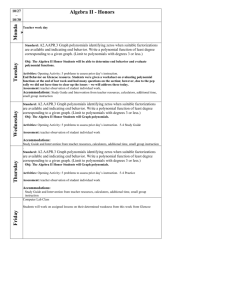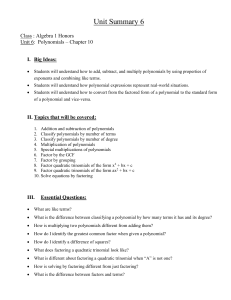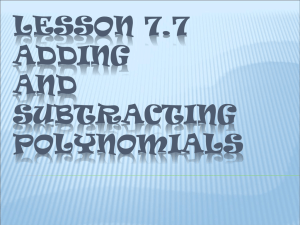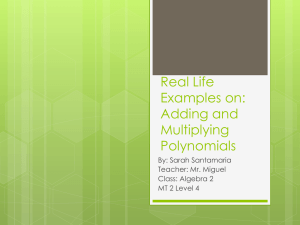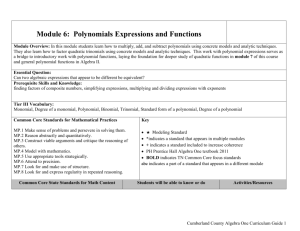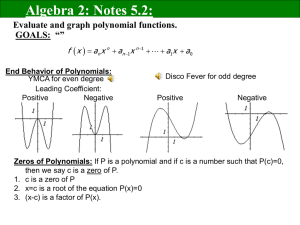Subject: Algebra 2 - Currituck County Schools
advertisement
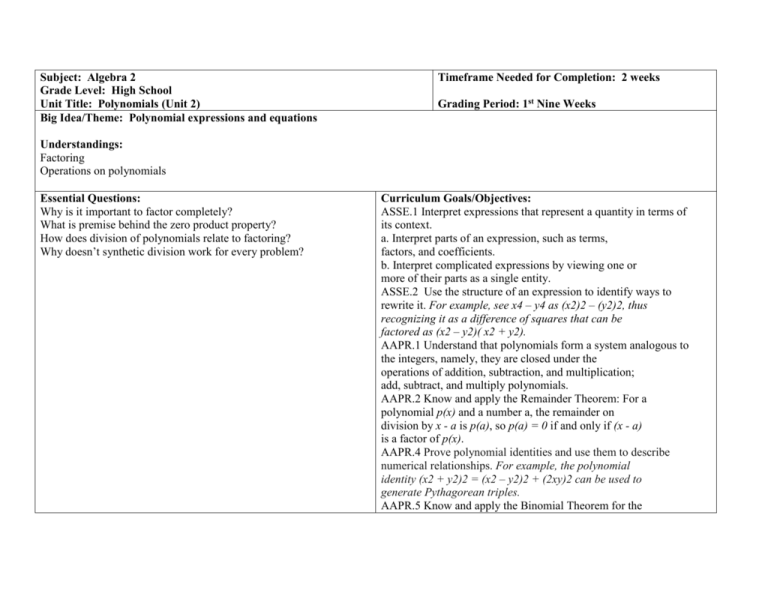
Subject: Algebra 2 Grade Level: High School Unit Title: Polynomials (Unit 2) Big Idea/Theme: Polynomial expressions and equations Timeframe Needed for Completion: 2 weeks Grading Period: 1st Nine Weeks Understandings: Factoring Operations on polynomials Essential Questions: Why is it important to factor completely? What is premise behind the zero product property? How does division of polynomials relate to factoring? Why doesn’t synthetic division work for every problem? Curriculum Goals/Objectives: ASSE.1 Interpret expressions that represent a quantity in terms of its context. a. Interpret parts of an expression, such as terms, factors, and coefficients. b. Interpret complicated expressions by viewing one or more of their parts as a single entity. ASSE.2 Use the structure of an expression to identify ways to rewrite it. For example, see x4 – y4 as (x2)2 – (y2)2, thus recognizing it as a difference of squares that can be factored as (x2 – y2)( x2 + y2). AAPR.1 Understand that polynomials form a system analogous to the integers, namely, they are closed under the operations of addition, subtraction, and multiplication; add, subtract, and multiply polynomials. AAPR.2 Know and apply the Remainder Theorem: For a polynomial p(x) and a number a, the remainder on division by x - a is p(a), so p(a) = 0 if and only if (x - a) is a factor of p(x). AAPR.4 Prove polynomial identities and use them to describe numerical relationships. For example, the polynomial identity (x2 + y2)2 = (x2 – y2)2 + (2xy)2 can be used to generate Pythagorean triples. AAPR.5 Know and apply the Binomial Theorem for the expansion of (x + y)n in powers of x and y for a positive integer n, where x and y are any numbers, with coefficients determined for example by Pascal’s Triangle. AAPR.6 Rewrite simple rational expressions in different forms; write a(x)/b(x) in the form q(x) + r(x)/b(x), where a(x), b(x), q(x), and r(x) are polynomials with the degree of r(x) less than the degree of b(x), using inspection, long division, or, for the more complicated examples, a computer algebra system. FIF.7.C Graph functions expressed symbolically and show key features of the graph, by hand in simple cases and using technology for more complicated cases. c. Graph polynomial functions, identifying zeros when suitable factorizations are available, and showing end behavior. FIF.8.A Write a function defined by an expression in different but equivalent forms to reveal and explain different properties of the function. a. Use the process of factoring and completing the square in a quadratic function to show zeros, extreme values, and symmetry of the graph, and interpret these in terms of a context. Essential Skills/Vocabulary: Closure FOIL Zeros Maximum/minimum Like terms Degree of a polynomial Materials Suggestions: Prentice Hall Algebra 2 Assessment Tasks: Apply properties of exponents Perform operations on polynomials and discuss closure under the set of integers Simply polynomial expressions using long division and synthetic division Evaluate a function using the Remainder Theorem Expand a polynomial using Pascal’s Triangle and the Binomial Theorem Factor polynomial expressions (quadratics, cubes, quartics) Use synthetic division to factor Use polynomial identities to rewrite and solve a function Rewrite polynomials as difference of squares to factor Draw quadratic and linear graphs to include zeros, intercepts, maximum/minimum, and end behavior

